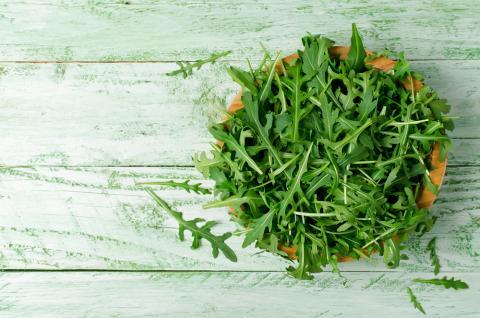
Arugula is also known as “rocket” and is originally a Eurasian cruciferous plant related to cauliflower, kale, and mustard. It grows wild in Asia and the Mediterranean basin and takes its name from the Latin term “eurca,” meaning caterpillar, because of the plant’s hairy stems. The arugula flavor is similar to horseradish or mustard leaves, and is used in salads to add a tangy dimension; the spicy aroma makes it a natural pest repellent.
While a popular plant throughout history, its use in England and Germany fluctuated, yet it was brought to America by the British colonists but did not gain popularity in the United States until the 1990s. For centuries this plant has been used for food and medicinal purposes and has been mentioned in several religious texts. Arugula was also mentioned in one of Virgil’s poems as a favorite salad ingredient. Pliny the Elder’s Historia Naturalis in 77 C.E. tells of the plant being used as an anesthesia. The Romans used it as an aphrodisiac and Ayurveda uses the seed oil.
Arugula grows best in moderate to cool climates and can grow in either wet or dry soil. In hot climates the leaves take on a bitter flavor, but it normally has a spicy aroma. You can also grow them as microgreens—the perfect size for adding to sandwiches and salads.
Health Benefits Of Arugula
Ayurveda uses the plant for pitta tendencies because the plant detoxifies the liver, which is the main pitta organ in the body. It is especially useful during the hot summer months when the organ tends to overheat. Arugula is rich in nutrients, and thus, is a holistic aid to healing. Aside from containing vitamins K, A and folate, chemical compounds in arugula known as isothiocynates lower the incidence of cancer and inflammation in the body. It also contains proteins, fiber, calcium, manganese and vitamin C.
Arugula is helpful in lowering the risk of cancer because it contains glucosinolates that are primary chemicals of phytonutrients that combine with saliva when chewed, transforming them into cancer-fighting isothiocyanates. This enzyme is what gives this and other cruciferous vegetables their sulfur scent and neutralizes the free radicals and other carcinogens that damage and mutate cells.
Containing a significant quantity of protective carotenoid antioxidants, arugula is beneficial for ocular health. It strengthens the retina, cornea, and other parts of the eye, protecting them from damage caused by exposure to ultra-violet light. It also lessens the risk of macular degeneration because of the high carotene content in the plant. It is the presence of lutein and zeaxanthin in arugula that protects against other ocular diseases by absorbing blue light.
Arugula is effective in lowering the risk of heart disease and is beneficial to the circulatory system. Its anti-inflammatory properties and high fiber content lower levels of cholesterol and balance blood pressure. High in potassium and magnesium, arugula controls heart rhythm.
For a strong skeletal system arugula provides the body with vitamin K, which is essential for bone health—even more effective than calcium. It lessens the risk of fractures and the development of osteoporosis. It is also one of the primary aids in clotting blood, which is an important factor in healing wounds.
Arugula is an excellent food for those with diabetes because it regulates insulin response. It is effective in reducing hyperglycemia and lowering the presence of triglycerides. It is free of sugars and carbohydrates, lowering the levels of blood sugar and inflammation.
Other benefits of eating arugula are that it is filling and adds roughage to help digestion and weight reduction. It protects the skin from damaging ultra-violet light and the effects of aging. The presence of folate lessens the risk of birth defects during pregnancies and reduces harmful blood chemicals in the body. Containing manganese, arugula helps the body absorb calcium. The plant also has trace minerals like iron, potassium, zinc, copper and magnesium.
Arugula is an excellent detox for the body and adds energy, reduces mood swings and is beneficial to the reproductive system. It is a delicious addition to salads and can be a substitute for lettuce in sandwiches. The young leaves are used in salads and old leaves are cooked in stews, soups, and side dishes. These are fragile leaves that should be bought when green with no yellow spots and should be used within a few days of purchase. They should be stored in the refrigerator after dried and wrapped in a paper towel to absorb moisture. Arugula can be served with goat cheese, tomatoes, olive oil, and garlic, and the wilted leaves can be blended into a dip.
Arugula Recipes
Get more arugula in your diet with these recipes!
- Buddha Bowl
- Smoked Salmon Salad
- Best of the Harvest Salad
- Apricot Goat Cheese Salad
- Vegan Breakfast Hash
- Cauliflower Crust Pizza
- Blue-Green Smoothie








